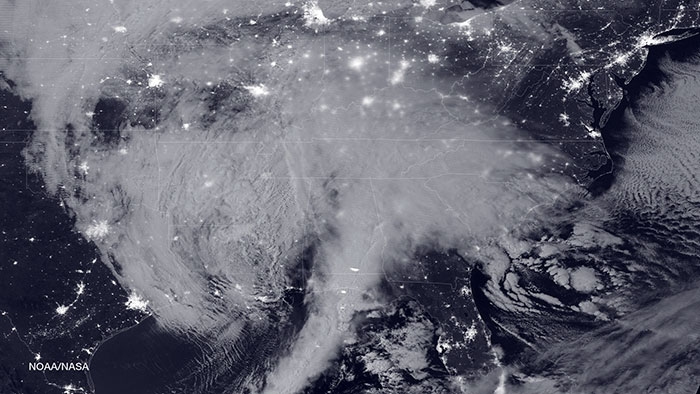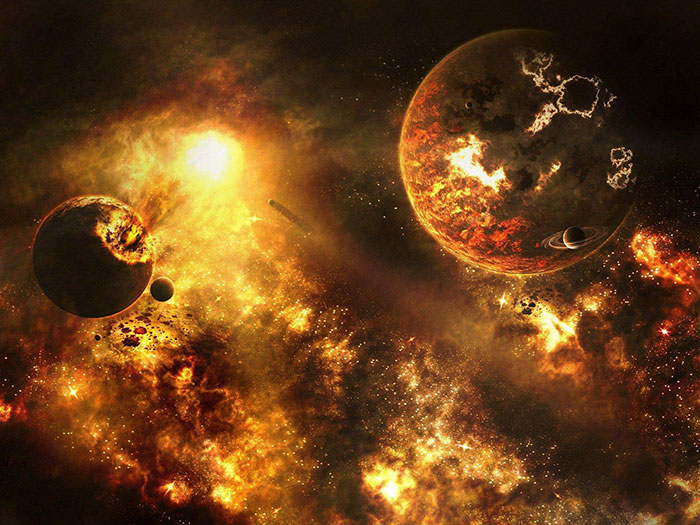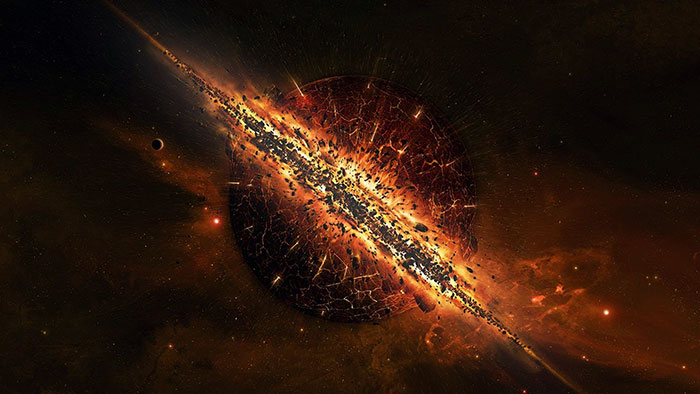
33 Things That Will Happen To Earth In The Next Trillion Years According To Scientists
People have always been curious, not only about the future of humanity but also the fate of planet Earth and the universe itself. However these days, the threat that climate change poses makes us think about our planet's future even more often. Although scientists cannot answer for certain what will happen thousands or million years into the future, they try to map the future with information and technology that is available today.
Imgur user WannaWanga did some digging around the internet and gathered a brief timeline of the far-future. If you're interested in these scientific predictions of the fate of the universe, scroll below!
More info: sciencealert.com | en.wikipedia.org | informationisbeautiful.net | mnn.com | imgur.com
This post may include affiliate links.
10,000 Years Into The Future
If a failure of the Wilkes Subglacial Basin "ice plug" in the next few centuries were to endanger the East Antarctic Ice Sheet, it will take up to this long to melt completely. Sea levels would rise 3 to 4 meters. (One of the potential long-term effects of global warming, this is separate from the shorter term threat of the West Antarctic Ice Sheet.)
According to one estimate called the Doomsday argument, as proposed by Australian theoretical physicist Brandon Carter, there's a 95 percent chance that humans will have died out in 10,000 years. That argument has been heavily debated, so we're not entirely sure if people will be around or not. But if they are, in 10,000 years there will be no regional genetic variation between humans. That's not to say people will all look the same, but whatever genetic differences there are - such as blue eyes versus brown - will be evenly distributed across the planet.
13,000 Years Into The Future
By this point, halfway through the precessional cycle, Earth's axial tilt will be reversed, causing summer and winter to occur on opposite sides of Earth's orbit. This means that the seasons in the Northern Hemisphere, which experiences more pronounced seasonal variation due to a higher percentage of land, will be even more extreme, as it will be facing towards the Sun at Earth's perihelion and away from the Sun at aphelion.
How will it be in the Southern Hemisphere? Will the seasons be less pronounced?
15,000 Years Into The Future
According to the Sahara pump theory, the precession of Earth's poles will move the North African Monsoon far enough north to convert the Sahara back into a tropical climate, as it was during 5,000–10,000 years ago.
That's awesome! I'm just worried that humans set up shop there, they'l just be disappointed again as the area becomes a desert once again. Then again, it'll take thousands of years to do so, sooooo
20,000 Years Into The Future
The Chernobyl Exclusion Zone, the 2,600-square-kilometre (1,000 sq mi) area of Ukraine and Belarus left deserted by the 1986 Chernobyl disaster, becomes safe for human life.
The pictures of the plant life affected are eye-opening, to say the least. Humans need to watch themselves around nuclear power.
36,000 Years Into The Future
The small red dwarf Ross 248 will pass within 3.024 light-years of Earth, becoming the closest star to the Sun. It will recede after about 8,000 years, making first Alpha Centauri again and then Gliese 445 the nearest stars.
The Alpha Centauri star system is made up of three stars, of which Proxima Centauri is the closest, and may be again after Ross recedes.
50,000 Years Into The Future
Niagara Falls will have eroded away the remaining 32 km to Lake Erie, and ceased to exist.
According to Berger and Loutre, the current interglacial period ends sending the Earth back into a glacial period of the current ice age, regardless of the effects of anthropogenic global warming.
The many glacial lakes of the Canadian Shield will have been erased by post-glacial rebound and erosion.
The length of the day used for astronomical timekeeping reaches about 86,401 SI seconds, due to lunar tides decelerating the Earth's rotation. Under the present-day timekeeping system, either a leap second would need to be added to the clock every single day, or else by then, in order to compensate, the length of the day would have had to have been officially lengthened by one SI second.
100,000 Years Into The Future
The hypergiant star VY Canis Majoris will likely have exploded in a hypernova.
The proper motion of stars across the celestial sphere, which is the result of their movement through the Milky Way, renders many of the constellations unrecognisable. Earth will likely have undergone a supervolcanic eruption large enough to erupt 400 km3 (96 cubic miles) of magma. For comparison, Lake Erie is 484 km3 (116 cu mi).
As one of the long-term effects of global warming, 10% of anthropogenic carbon dioxide will still remain in a stabilized atmosphere. (100,000+)
200,000 Years Into The Future
Due to "proper motion," or the long-term movement of celestial bodies through space, familiar star constellations like the Big Dipper, Orion and Perseus no longer exist.
250,000 Loihi, a young submarine volcano in the Hawaiian chain, rises above the Pacific Ocean's surface and becomes a new island.
295,000 Voyager 2 vs Sirius probe passes within 4.7 light years of the brightest star in the night sky.
300,000 Years Into The Future
At some point in the next "several" hundred thousand years, the Wolf–Rayet star WR 104 is expected to explode in a supernova. It has been suggested that it may produce a gamma-ray burst that could pose a threat to life on Earth should its poles be aligned 12° or lower towards Earth. The star's axis of rotation has yet to be determined with certainty.
500,000 Years Into The Future
Earth will likely have been hit by an asteroid of roughly 1 km in diameter, assuming it cannot be averted.
The spent nuclear fuel in today's reactors will finally be safe.
The rugged terrain of Badlands National Park in South Dakota will have eroded away completely.
Final date we can hold off a new global freeze until - if we burn all remaining fossil fuels.
1 Million Years Into The Future
Earth will likely have undergone a supervolcanic eruption large enough to erupt 3,200 km3 (770 cubic miles) of magma, an event comparable to the Toba supereruption 75,000 years ago.
Highest estimated time until the red supergiant star Betelgeuse explodes in a supernova. The explosion is expected to be easily visible in daylight. It may explode in as little as 100,000 years, depending on the evolutionary model.
All glass created to date will have finally degraded. Massive stone structures like Giza or sculptures at Mount Rushmore may still exist. Everything else gone.
Desdemona and Cressida, moons of Uranus, will likely have collided.
"Massive stone structures like Giza or sculptures at Mount Rushmore may still exist." → This one makes me imagine that, meanwhile, intelligent life developed on another planet, which population is examining Earth the way we are examining Mars, seeing those ruins and debating the everlasting question: "are we alone in this universe?"
2 Million Years Into The Future
Estimated time for the recovery of coral reef ecosystems from human-caused ocean acidification; a similar time was taken for the recovery of marine ecosystems after the acidification event that occurred about 65 million years ago .
The Grand Canyon will erode further, deepening slightly, but principally widening into a broad valley surrounding the Colorado River.
2.7 million, Average orbital half-life of current centaurs, that are unstable because of gravitational interaction of the several outer planets.
10 Million Years Into The Future
The widening East African Rift valley is flooded by the Red Sea, causing a new ocean basin to divide the continent of Africa and the African Plate into the newly formed Nubian Plate and the Somali Plate.
Estimated time for full recovery of biodiversity after a potential Holocene extinction, if it were on the scale of the five previous major extinction events.
Even without a mass extinction, by this time most current species will have disappeared through the background extinction rate, with many clades gradually evolving into new forms.
50 Million Years Into The Future
Maximum estimated time before the moon Phobos collides with Mars.
According to Christopher R. Scotese, the movement of the San Andreas Fault will cause the current locations of Los Angeles and San Francisco to merge.
The Californian coast will begin to be subducted into the Aleutian Trench.
Africa's collision with Eurasia closes the Mediterranean Basin and creates a mountain range similar to the Himalayas.
The Appalachian Mountains peaks will largely erode away, weathering at 5.7 Bubnoff units, although topography will actually rise as regional valleys deepen at twice this rate.
100 Million Years Into The Future
Upper estimate for lifespan of the rings of Saturn in their current state.
Earth will likely have been hit by an asteroid comparable in size to the one that triggered the K–Pg extinction 66 million years ago, assuming it cannot be averted.
noooooooooooooooooooooooooooooooooooooooooooooooooooooooooooooooooooooooooooooooooooooooooooooooooooooooooooooooooooooooooooooooooooooooooooooooooooooooooooooooooooooooooooooooooooooooooooooooooooooooooooooooooooooooooooooooooooooooooooooooooooooooooooooooooooooooooooooooooooooooooooooooooo!!!!!!!!!!!!!!!!!!!!!!!!!!!!!!!!!!!!!!!!!!!!!!!!!!!!!!!!!!!!!!!!!!!!!!!!!!!!!!!!!!!!!!!!!!!!!!!!!!!!!!!!!!!!!!!!!!!!!!!!!!!!!!!!!!!!!!!!!!!!!!!!!!!!!!!!!!!!!!!!!!!!!!!!!!!!!!!!!!!!!!!!!!!!!!!!!!!!!!!!!!!!!!!!!!!!!!!!!!!!!!!!!!!!!!!!!!!!!!!!!!!!!
250 Million Years Into The Future
All the continents on Earth may fuse into a supercontinent. Three potential arrangements of this configuration have been dubbed Amasia, Novopangaea, and Pangaea Ultima.
Due to the northward movement of the West Coast of North America, the coast of California will collide with Alaska.
The solar system will have completed one entire revolution around the Milky Way.
Alaska will finally be part of the United States, but neither will still exist.....and neither will humans. Can't decide if that's for better or for worse tho
600 Million Years Into The Future
The Sun's rising luminosity begins to disrupt the carbonate–silicate cycle; higher luminosity raises weathering of surface rocks, which traps carbon dioxide in the ground as carbonate. Volcanoes will continue to pump carbon dioxide for at least the next 1.1 billion years.However, the long term trend is for the carbon dioxide level to steadily drop.
By this time, carbon dioxide levels will fall to the point at which C3 photosynthesis used by trees is no longer possible. By this point, forests will no longer be able to survive, causing a mega mass extinction of the Earth's vegetation.
Tidal acceleration moves the Moon far enough from Earth that total solar eclipses are no longer possible.
Wait, what? You're saying that in 600 million years, the projection is that trees will no longer be able to grow? That's not that long in the grand timescale of earth.
800 Million Years Into The Future
Carbon dioxide levels fall to the point at which C4 photosynthesis is no longer possible. Without plant life to recycle oxygen in the atmosphere, free oxygen and the ozone layer will disappear from the atmosphere allowing for intense levels of deadly UV light to reach the surface. However, in their book The Life and Death of Planet Earth, authors Peter D. Ward and Donald Brownlee stated that some animal life may be able to survive in the oceans. However, due to a lessening of organic matter and oxygen in the water,animal life would die off there too. By this time all multicellular life will die out. The only life left on the Earth after this will be single celled bacteria.
I am almost tempted to find and read that book... doesn't it seem likely that at least *some* plants and animals would evolve - over the hundreds of millions of years that the carbon dioxide level is falling - to make use of the new chemical composition of the air? (Assuming that any have survived the previous global catastrophes, and/or re-evolved since those events.)
1 Billion Years Into The Future
The Sun's luminosity has risen by 10%, causing Earth's surface temperatures to reach an average of c. 320 K (47 °C; 116 °F). The atmosphere will become a "moist greenhouse", resulting in a runaway evaporation of the oceans. As water evaporates from the Earth's surface, rocks harden, causing plate tectonics to slow and eventually stop. Pockets of liquid water may still be present at the poles or at high elevations, allowing small areas where life can survive.
1.3 Billion, Eukaryotic life dies out on Earth due to carbon dioxide starvation. Only prokaryotes remain.
1.5 to 1.6 Billion, The Sun's rising luminosity causes its circumstellar habitable zone to move outwards; as carbon dioxide rises in Mars's atmosphere, its surface temperature rises to levels akin to Earth during the ice age.
2 Billion Years Into The Future
The Earth's outer core freezes, if the inner core continues to grow at its current rate of 1 mm per year. Without its liquid outer core, the Earth's magnetic field shuts down, and charged particles emanating from the Sun gradually deplete the atmosphere.
Earth's surface temperature, even at the poles, reaches an average of c. 422 K (149 °C; 300 °F). At this point, all life, now reduced to unicellular colonies in isolated, scattered micro-environments such as high-altitude lakes or subsurface caves, will go extinct.
3 Billion Years Into The Future
There is a roughly 1 in 100,000 chance that the Earth might be ejected into interstellar space by a stellar encounter before this point, and a 1 in 3 million chance that it will then be captured by another star. Were this to happen, life, assuming it survived the interstellar journey, could potentially continue for far longer.
Median point at which the Moon's rising distance from the Earth lessens its stabilizing effect on the Earth's axial tilt. As a consequence, Earth's true polar wander becomes chaotic and extreme, leading to dramatic shifts in the planet's climate due to the changing axial tilt. If the Earth's tilt exceeds 54°, then the poles will receive more solar radiation than the equator. The planet's tilt could shift to as high as 60° - 90° for periods of 10 million years.
3.6 Billion, Neptune's moon Triton falls through the planet's Roche limit, potentially disintegrating into a planetary ring system similar to Saturn's.
4 Billion Years Into The Future
Median point by which the Andromeda Galaxy will have collided with the Milky Way, which will thereafter merge to form a galaxy dubbed "Milkomeda". The planets of the Solar System are expected to be relatively unaffected by this collision
5 Billion Years Into The Future
With the hydrogen supply exhausted at its core, the Sun leaves the main sequence and begins to evolve into a red giant.
7 Billion Years Into The Future
Earth and Mars may become tidally locked with the expanding subgiant Sun.
The Earth and Moon are very likely destroyed by falling into the Sun, just before the Sun reaches the tip of its red giant phase and its maximum radius of 256 times the present-day value. Before the final collision, the Moon possibly spirals below Earth's Roche limit, breaking into a ring of debris, most of which falls to the Earth's surface. During this time, most of the Earth's atmosphere will be lost to space and it's surface will consist of a lava ocean with flouting continents of metals and metal oxides as well as icebergs of refractory materials, with an average temperature of over 2,400 K (2,130 °C; 3,860 °F). During this era, Saturn's moon Titan may reach surface temperatures necessary to support life.
The Sun reaches the tip of the red-giant branch of the Hertzsprung–Russell diagram, achieving its maximum radius of 256 times the present-day value. In the process, Mercury, Venus, very likely Earth, and possibly Mars are destroyed.
8 Billion Years Into The Future
The Sun becomes a carbon-oxygen white dwarf with about 54.05% its present mass. At this point, if somehow the Earth survives, temperatures on the surface of the planet, as well as other remaining planets in the Solar System, will begin dropping rapidly, due to the white dwarf Sun emitting much less energy than it does today.
14 Billion Years Into The Future
The Sun becomes a black dwarf. Its temperature and luminosity plummets, making it invisible to human eyes (not that they exist anymore).
unless we've moved planets which alost definitely have it is said in 10 yrs the amount of technology that has been upgraded or changed from 1918 - 2018 will have changed so I imagine by this time we will be documenting the sun with some sought of probe or walking on the sun for a holiday!
50 Billion Years Into The Future
If the Earth and Moon are not engulfed by the Sun, by this time they will become tidelocked, with each showing only one face to the other. Thereafter, the tidal action of the white dwarf Sun will extract angular momentum from the system, causing the lunar orbit to decay and the Earth's spin to accelerate.
22 Billion Years Into The Future
The end of the Universe in the Big Rip scenario, assuming a model of dark energy with w = −1.5. If the density of dark energy is less than -1, then the Universe's expansion would continue to accelerate and the Observable Universe would continue to get smaller. Around 200 million years before the rip, galaxy clusters like the Local Group or the Sculptor Group would be destroyed. 60 million years before the rip, all galaxies will begin to lose stars around their edges and will completely disintegrate in another 40 million years. Three months before the Rip, all star systems will become gravitationally unbound, and planets will fly off into the rapidly expanding universe. 30 minutes before the end, planets, stars, asteroids and even extreme objects like neutron stars and black holes will evaporate into atoms. 10−19 seconds before the end, atoms would break apart and right at the moment of the rip even space time itself would disintegrate. The universe would enter into a "rip singularity" when all distances become infinitely large.
100 Billion Years Into The Future
The Universe's expansion causes all galaxies beyond the former Milky Way's Local Group to disappear beyond the cosmic light horizon, removing them from the observable universe
150 Billion, The cosmic microwave background cools from its current temperature of c. 2.7 K to 0.3 K, rendering it essentially undetectable with current technology
1 Trillion Years Into The Future
Estimated time the end of the Universe via the Big Crunch, assuming a "closed" model. Depending on how long the expansion phase is, the events in the contraction phase will happen in the reverse order. Galaxy superclusters would first merge, followed by galaxy clusters and then later galaxies. About 100,000 years before the Big Crunch, stars have become so close together that they will begin to collide with each other. Also, the cosmic microwave background temperature will rise to about 100,000 K (100,000 °C; 180,000 °F), which means that stars will no longer be able to expel their internal heat, slowly cooking themselves until they explode. Minutes before the Big Crunch, the temperature will be so great that atomic nuclei will disband and the partials will be sucked up by already coalescing black holes. Finally, all the black holes in the universe will merge into one singular black hole containing all the matter in the universe, which it would then devour the universe, including itself.
After this, it is possible that a new Big Bang would follow and create a new universe. The observed actions of dark energy do not support this scenario; however, the properties of dark energy are still not known, it is possible that dark energy could reverse sometime in the future.
The universe's expansion, assuming a constant dark energy density, multiplies the wavelength of the cosmic microwave background by 1029, exceeding the scale of the cosmic light horizon and rendering its evidence of the Big Bang undetectable. However, it may still be possible to determine the expansion of the universe through the study of hypervelocity stars.
100 Trillion Years Into The Future
High estimate for the time until normal star formation ends in galaxies. This marks the transition from the Stelliferous Era to the Degenerate Era; with no free hydrogen to form new stars, all remaining stars slowly exhaust their fuel and die
110–120 Trillion, The stellar-mass objects remaining are stellar remnants (white dwarfs, neutron stars, black holes) and brown dwarfs.
Collisions between brown dwarfs will create new red dwarfs on a marginal level: on average, about 100 stars will be shining in what was once the Milky Way. Collisions between stellar remnants will create occasional supernovae.
10^10^50 Years
Estimated time for a Boltzmann brain to appear in the vacuum via a spontaneous entropy drop.
The chances of this happening are so small that the last star will die long before it happens. However, the vast majority of our universe’s life will take place not before, but after all the stars have died.
10^10^10^56
Around this vast timeframe, quantum tunnelling in any isolated patch of the vacuum could generate, via inflation, new Big Bangs giving birth to new universes.
I read all this while stoned af and now I'm having an existential crisis :/
Don't freet, some believe the cold crunch will lead to a new big bang and space and time will recycle. Meaning everything that ever was and ever happen will happen again. Meaning you will get stoned again, read this again, comment again, and I will read your comment and reply to hopefully cheer you up a bit again. Now go eat and watch Tom Segua on Netflix.
Load More Replies...Although this was interesting, my brain is now a vacuum of space...and goop
Are you certain it wasn't goop prior to reading it?? (jk)
Load More Replies...I read all this while stoned af and now I'm having an existential crisis :/
Don't freet, some believe the cold crunch will lead to a new big bang and space and time will recycle. Meaning everything that ever was and ever happen will happen again. Meaning you will get stoned again, read this again, comment again, and I will read your comment and reply to hopefully cheer you up a bit again. Now go eat and watch Tom Segua on Netflix.
Load More Replies...Although this was interesting, my brain is now a vacuum of space...and goop
Are you certain it wasn't goop prior to reading it?? (jk)
Load More Replies...
 Dark Mode
Dark Mode 

 No fees, cancel anytime
No fees, cancel anytime 













































































































